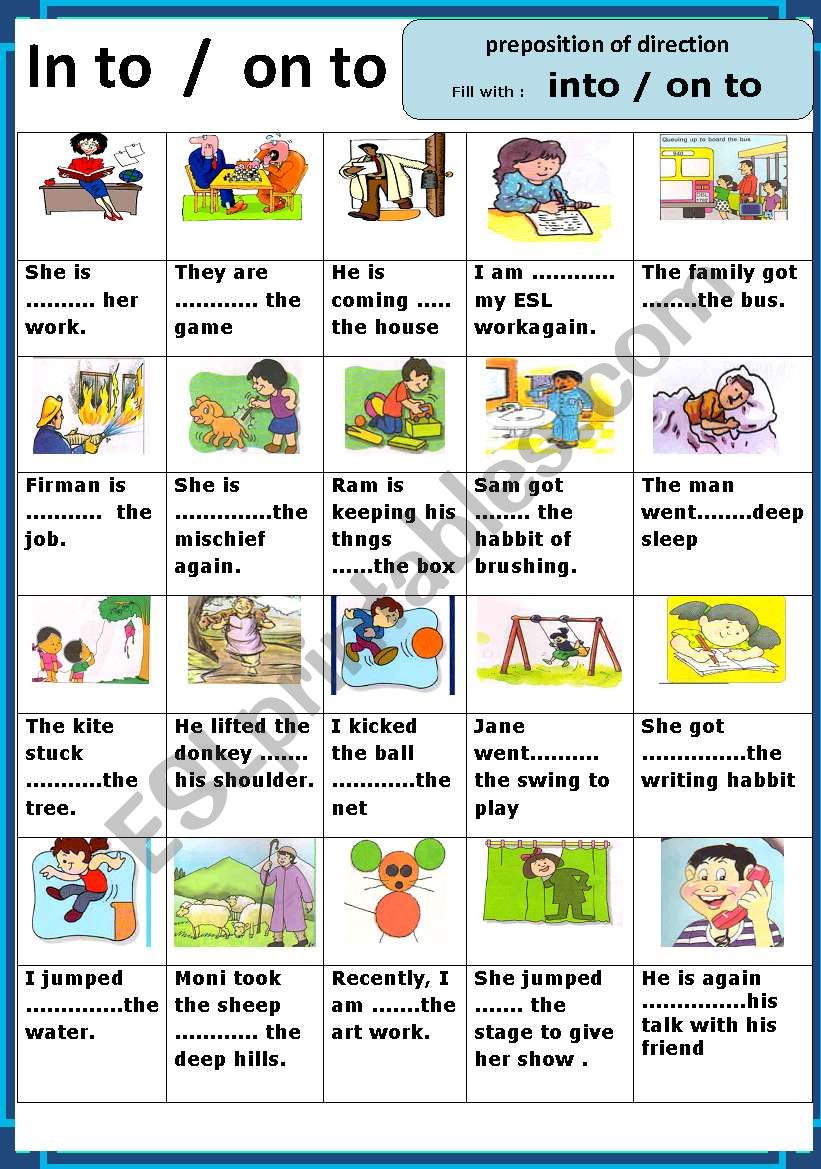We all encounter prepositions like “onto” and “into” daily, often without giving them much thought. But how often do we stop and consider their nuanced differences? As a writer, I struggled for years with the correct usage of these seemingly interchangeable words. It wasn’t until I delved deeper into their meanings that I truly understood their distinct roles in conveying movement and position. Today, I’m excited to share that knowledge with you and unravel the intricacies of “onto” vs. “into.”

Image: in.pinterest.com
You might be surprised to learn that the seemingly straightforward distinction between these prepositions can be a source of confusion for many. This confusion often stems from their shared ability to express movement towards a destination. However, the true difference lies in the nature of that destination and the type of movement involved. This article will explore the subtle yet crucial distinctions between “onto” and “into” to empower you with a deeper understanding of these prepositions and their proper usage.
The Essence of “Onto”
The preposition “onto” denotes a movement that results in something being placed *on top of* another object or surface. It emphasizes the change in vertical position, implying that something is now situated *on top* rather than beside or underneath. Think of it as a journey towards a platform, a landing spot, or a literal “on-top” position.
Here are some examples of “onto” in action:
- The cat jumped onto the table.
- She carefully placed the delicate vase onto the shelf.
- He climbed onto the stage to deliver his speech.
The Essence of “Into”
In contrast to “onto,” the preposition “into” emphasizes a movement *inside* something. It suggests that something is now enclosed or contained within another object, space, or area. Think of “into” as a journey through a boundary, entering a new dimension, or a transition from the outside to the inside.
Here are some examples of “into” in action:
- The children ran into the playground.
- He poured the milk into the bowl.
- She walked into the store and bought a book.
Exploring the Differences in Usage
The key difference between “onto” and “into” lies in the direction and dimension of movement. “Onto” suggests a change in vertical position, implying a placement *on top* of something. “Into” suggests a change in spatial position, implying entering *inside* something.
Consider these contrasting examples:
- “The bird flew onto the branch.” (Focus on the bird’s position on top of the branch)
- “The bird flew into the nest.” (Focus on the bird’s entry into the enclosed space of the nest)

Image: www.animalia-life.club
Tips and Expert Advice for Correct Usage
While “onto” and “into” have distinct meanings, their correct usage can sometimes feel intuitive. However, here are some tips to help you avoid common mistakes:
Tip 1: Consider the Destination
Ask yourself: Where is the movement ultimately leading? If the destination is a surface or a position *on top* of something, “onto” is likely the correct choice. If the destination is a space or a location *inside* something, “into” is more appropriate.
Tip 2: Visualize the Movement
Imagine the action in your mind. If you see something moving from a lower position to a higher position, landing *on top* of something, “onto” is the way to go. If you see something passing through a boundary or entering a closed space, “into” is likely the correct word.
FAQ: Solving Common Questions
Q: Is it always “onto” when dealing with movement upwards?
A: Not necessarily. While “onto” often describes upward movement, it’s not always the case. For instance, you might say “The climber ascended onto the rock face,” but you’d say “The climber crawled into the cave,” even though both involve an upward direction.
Q: Can I use “onto” and “into” interchangeably in some situations?
A: While rare, there are a few instances where “onto” and “into” can be used interchangeably without changing the meaning significantly. For example, you might say “He walked onto/into the train,” implying a transition from the platform to the enclosed space of the train.
Q: What are some other prepositions that express movement?
A: Besides “onto” and “into,” other prepositions that express movement include:
- Through
- Across
- Over
- Under
- Around
Onto Vs Into
Conclusion
Understanding the subtleties of “onto” and “into” can significantly enhance your writing style and clarity. Remember, “onto” implies movement towards a position *on top*, while “into” suggests a transition *inside* something. By visualizing the movement and considering the nature of the destination, you can confidently choose the correct preposition for any situation.
Are you interested in learning more about prepositions and their various nuances? Share your thoughts and questions in the comments below! We’d love to continue this exploration together.





